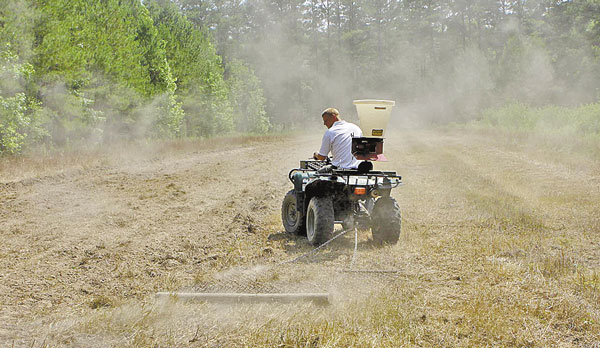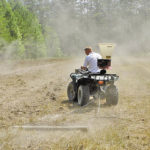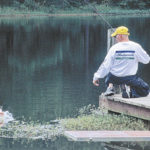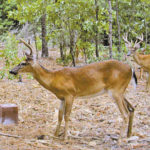
Warm-season food plots are already established by many habitat managers, with the exception of a choice few chasing Thanksgiving’s main squeeze, the tom turkey. These gobbler enthusiasts must hold off spring plantings until after the season passes to remain compliant with non-baiting laws.Often, cleared areas used for food plots are ideal locations for turkeys to conduct their mating rituals and to feed. Freshly-planted plots are super magnets for game birds, and hunting over these areas just after planting would be considered baiting.
Warm-season food plots freshly cultivated and spiked with tender seeds are prime attractants to wild turkeys and lots of other wildlife. The fields provide the new seed and lots of grubbing territory favored by turkeys in springtime. These areas draw turkeys from afar, sometimes decimating an entire warm-season plot before the seeds ever germinate.
Waiting until the end of turkey season is not really a bad move. The majority of warm-season plantings offer seeding periods from April well into May. In fact, Joe Hamilton, the Director of Education & Outreach of Quality Deer Management Association (QDMA) says the best 4-week period to plant summer food plots is the last two weeks of April through the first two weeks of May.
“Getting summer food plots established before late May allows the roots systems to get a foothold into the soil to take advantage of the available soil moisture,” he said.
Slightly later plantings also avoid the chance of a devastating frost. Cold spells routinely show up in the early part of April. but May is generally free of late-season frosts, lowering the chances of a freeze kill on newly-planted food plots.
However, warm-season food plots should be planted no later than the last few weeks of May to gain full-season benefits. As soil temperature rise, weed seeds begin to germinate, offering competition to prescribed food-plot seed. The earlier in May it’s planted will give the food plot adequate time to get established and to provide full season benefits.
Tilapia: A perfect pond fish?
Tilapia is the finned fad taking over restaurant menus and supermarkets because of its inexpensive, delicate and ever-so-tasty flesh.
Originally from Africa, tilapia have historic importance dating back to biblical times; they were known as “St. Peter’s Fish’ in the New Testament. In fact, tilapia should be considered the new superfish in America — or for pond anglers in the south, anyway. They will smack brightly colored crappie jigs and micro-sized crank baits during the heat of summer!
Tilapia are considered a superfish for most farm ponds, with tremendous benefits and little detrimental effect. Often referred to as bluegill on steroids, tilapia will rid a pond of its filamentous algae problems. Although they are considered omnivorous, their diet consists of aquatic vegetation and detritus, with little affection for insects and worms. In order to fuel their rapid growth rate, tilapia must consume large quantities of vegetation, providing season-long aquatic weed control in southern ponds.
Unlike the infamous grass carp, tilapia will reproduce quickly and will consume problem filamentous algae and other plant fibers. But tilapia are short-lived and cannot tolerate cool temperatures. In fact, they will die when water temperatures reach 50 degrees. Even in temperatures up to 60 to 65 degrees, tilapia will become sluggish, often swimming lazily along the surface.
Tilapia spawn every month, and their fingerlings will be present throughout the summer. Largemouth bass and hybrid bass will love the extra food source. These additional forage fishes will relieve native bluegill stocks, boosting size gains with bluegill as well. As the tilapia die out in the winter, the additional bluegill will be controlled over the fall and winter months by the fatter bass looking to replace their abundant summer food source.
Tilapia are generally stocked as 3- to 4-inch fingerlings when water temperatures rise above 70 degrees. Tilapia will start spawning just after a few weeks and will quickly grow to nearly two pounds by the peak of the season.
With all of the positive benefits of tilapia introduction in farm ponds, several negative impacts can quickly cause problems for pond owners. The two major issues are eradication of pond vegetation in ponds lacking abundant natural weeds, and under-balanced ponds with too few predators. Farm ponds adjacent to cattle farms or agriculture fields often have a high algae and weed problem from excess runoff. These ponds in agriculture settings are prime candidates. In ponds with little excess nutrient inputs, additional fertilization practices can mimic conditions and provide enough food for tilapia. In unbalanced ponds with too few predators, stocking tilapia can be detrimental to the pond, further adding to the unbalanced nature of the system. As with any management technique, every situation is a little different and existing conditions must be examined thoroughly before making decisions with new species introductions.
Already well known with many added health benefits for humans, now pond owners can have season-long weed control, big fat largemouth bass, a tasty fish dinner, and a hard-fighting sportfish in the backyard.
Refresh your mineral supplements
As the days get longer through the early spring, the change in photoperiod triggers the start of antler growth in whitetail bucks. Although only small bumps on the skull may be visible in early April and into May, their requirement for minerals has tripled. Mineral blocks and mineral stations are important for whitetails during the spring and into the fall.
Ideally, mineral blocks should be refreshed in January or February to allow deer to locate and begin absorbing these vital nutrients on a routine basis. But replenishing or introducing new mineral stations in spring is nearly as beneficial.
What kinds of minerals are important anyway? Often the term, “mineral” is thrown around without mentioning the key ingredients vital to antler growth. Calcium and phosphorus are the major players for antler growth. These two key ingredients, combined with a high-protein diet, are critical for growing heavy antlers.
A whitetail buck’s mineral requirement triples during antler growth. Even with the help of supplemental mineral sources, deer have a physiological response to provide the necessary minerals, especially at peak growth. The thyroid gland emits hormones, allowing minerals to be removed from their existing bone structure, later to be replaced after antler development commences.
Mineral blocks should not be confused with the typical white salt blocks used in the cattle business. While sodium as a supplement is critical to deer and should be a component, the blocks should also contain high levels of calcium and phosphorus. Sodium itself is a key mineral for deer. The amount of sodium in natural plant fibers and water is low and tends to be limiting. Animals use sodium to regulate blood pressure and water balance, and it is a major component of nerve impulses throughout the body.
As deer feed heavily on spring browse and uptake large quantities of water, sodium balance can becomes offset, and deer seek salt. During the spring and summer, deer will hone in on salt licks to receive its sodium as a key nutrient. Sometimes deer will travel long distances to benefit from an adequate sodium resource. Fortunately, the majority of mineral supplemental products contain high levels of salts, further enhancing their nutritional intake for regulating sodium balance and mineral uptake for optimal antler growth.
Mineral blocks and supplements come in block and powder form, with a variety of different flavor ingredients. However, the actual flavor ingredient, whether it be acorn, molasses, or any other food aroma, only marginally aids in use. The sensitive olfactory senses of deer will detect mineral blocks for their heavy sodium content, regardless of other flavor additives. Deer will quickly start using and continue to use until depleted. During May and throughout the summer, mineral supplements should be replenished and maintained throughout the farm. In order to provide optimal available resources for the herd, one mineral station should be placed at a minimum of every 100 acres — and preferably adjacent to a water source.







Be the first to comment